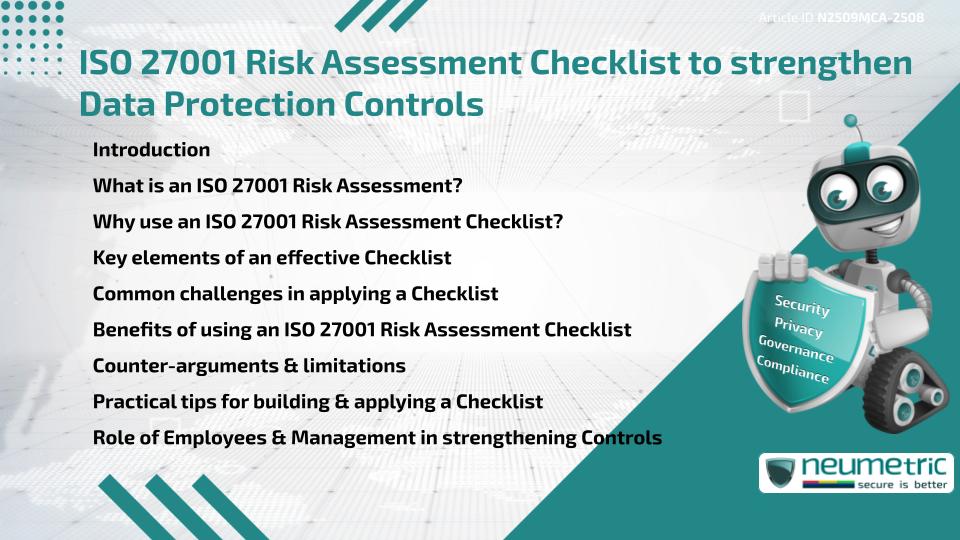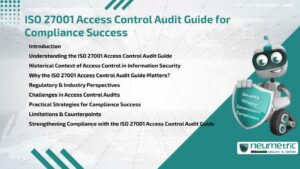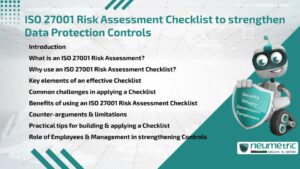Table of Contents
ToggleIntroduction
An ISO 27001 Risk Assessment Checklist is a valuable tool for Organisations aiming to strengthen Data Protection Controls. ISO 27001, the Global Standard for Information Security Management Systems [ISMS], requires Organisations to identify, evaluate & address Risks to Information Assets. A well-structured Checklist ensures nothing is overlooked during the Assessment process. It provides consistency, saves time & supports Certification readiness. This article explores what Risk Assessment means in ISO 27001, why a Checklist is useful, its key elements, common challenges, benefits & practical ways to apply it effectively.
What is an ISO 27001 Risk Assessment?
A Risk Assessment under ISO 27001 is the process of identifying Potential Threats to Information Assets, evaluating their Likelihood & Impact & determining how to mitigate them. It is a core requirement of the Standard & forms the basis for selecting appropriate Controls. Without thorough Risk Assessments, Organisations cannot claim to have an effective ISMS.
For more detail, visit ISO’s overview of ISO 27001.
Why use an ISO 27001 Risk Assessment Checklist?
Risk Assessments can be complex, especially in Large Organisations with many Assets. A Checklist brings structure & ensures consistency across Assessments. It helps Auditors & Staff follow a clear process & avoid missing critical steps. Using a Checklist also makes the process easier to repeat, which is essential since Risk Assessments must be updated regularly.
Key elements of an effective Checklist
An ISO 27001 Risk Assessment Checklist should include:
- Asset Identification: Listing all Information Assets including Hardware, Software, People & Data.
- Threat Identification: Documenting possible Threats such as Cyberattacks, Human error or Natural Disasters.
- Vulnerability Analysis: Identifying weaknesses that could be exploited.
- Risk Evaluation: Assessing the Likelihood & potential impact of Risks.
- Risk Treatment Options: Choosing whether to accept, transfer, mitigate or avoid Risks.
- Documentation Requirements: Ensuring all Findings & Decisions are recorded properly.
- Review Frequency: Defining when Assessments should be revisited & updated.
This Checklist works like a recipe-it provides step-by-step guidance to achieve consistent & reliable results.
Common challenges in applying a Checklist
Organisations often struggle with maintaining an accurate Asset Inventory, which undermines the entire Assessment process. Another challenge is overcomplicating the Checklist, which can discourage Employees from using it effectively. In some cases, Staff lack training on Risk Assessment methods, leading to inconsistent results. Additionally, Organisations may neglect to update the Checklist regularly, leaving gaps in Risk coverage.
Benefits of using an ISO 27001 Risk Assessment Checklist
A structured Checklist delivers several advantages:
- Improves consistency across Departments.
- Saves time by guiding Assessors through a clear process.
- Enhances Audit readiness by demonstrating Systematic Risk Management.
- Strengthens overall Data Protection Controls.
- Builds Staff confidence & engagement in the ISMS process.
Counter-arguments & limitations
Critics argue that Checklists can create a false sense of security if followed without deeper analysis. Over-reliance on Checklists may lead to box-ticking rather than genuine Risk Evaluation. Another limitation is that every Organisation faces unique Risks, so a generic Checklist must be tailored to specific Business contexts. While these points are valid, using a Checklist alongside Expert judgment provides the best balance of structure & flexibility.
Practical tips for building & applying a Checklist
- Keep the Checklist concise but comprehensive.
- Involve multiple Departments when designing it.
- Train Staff on how to use the Checklist effectively.
- Update it regularly to reflect changing Risks & Business needs.
- Integrate it with broader Compliance & Audit activities.
These tips ensure the ISO 27001 Risk Assessment Checklist remains relevant & practical over time.
Role of Employees & Management in strengthening Controls
Employees are responsible for following Procedures, reporting Risks & supporting accurate Assessments. Management must provide Leadership, Resources & oversight to ensure the Checklist is used effectively. Collaboration between both groups ensures the Organisation maintains robust Data Protection Controls.
Takeaways
- An ISO 27001 Risk Assessment Checklist brings structure & consistency.
- It should cover Assets, Threats, Vulnerabilities, Risks & Treatment options.
- Common challenges include poor Asset inventories & outdated Checklists.
- Benefits include stronger Controls, Audit readiness & Staff engagement.
- Effective Application requires Leadership support & regular Updates.
FAQ
What is an ISO 27001 Risk Assessment Checklist?
It is a structured tool that guides Organisations through the process of identifying, evaluating & treating Information Security Risks.
Why is a Checklist important in Risk Assessments?
A Checklist ensures consistency, prevents steps from being missed & makes the process easier to repeat.
What are the main elements of an ISO 27001 Risk Assessment Checklist?
They include Asset identification, Threat analysis, Vulnerability Assessment, Risk evaluation & Documentation.
Does using a Checklist guarantee Certification?
No, but it supports Compliance & improves the chances of a successful Certification Audit.
How often should a Risk Assessment Checklist be updated?
It should be reviewed at least annually or whenever major Business or Technological changes occur.
Can Small Businesses benefit from using a Checklist?
Yes, it simplifies the Risk Assessment process & makes it more manageable for Organisations with limited Resources.
What role does Management play in using a Checklist?
Management ensures the Checklist is properly implemented by allocating Resources & supporting Staff training.
Need help for Security, Privacy, Governance & VAPT?
Neumetric provides organisations the necessary help to achieve their Cybersecurity, Compliance, Governance, Privacy, Certifications & Pentesting needs.
Organisations & Businesses, specifically those which provide SaaS & AI Solutions in the Fintech, BFSI & other regulated sectors, usually need a Cybersecurity Partner for meeting & maintaining the ongoing Security & Privacy needs & requirements of their Enterprise Clients & Privacy conscious Customers.
SOC 2, ISO 27001, ISO 42001, NIST, HIPAA, HECVAT, EU GDPR are some of the Frameworks that are served by Fusion – a SaaS, multimodular, multitenant, centralised, automated, Cybersecurity & Compliance Management system.
Neumetric also provides Expert Services for technical security which covers VAPT for Web Applications, APIs, iOS & Android Mobile Apps, Security Testing for AWS & other Cloud Environments & Cloud Infrastructure & other similar scopes.
Reach out to us by Email or filling out the Contact Form…





